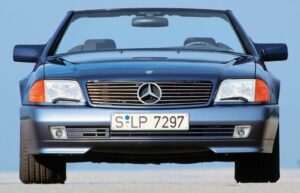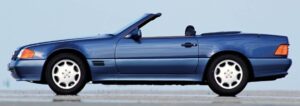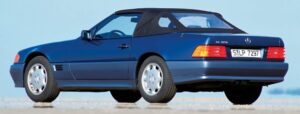1993 Mercedes SL: A new name, new engines, new era
1. A new era for the Mercedes-Benz SL
2. New engines for a new identity
4. AMG joins the official lineup
A new era for the Mercedes-Benz SL
In July 1993, Mercedes-Benz reshaped not only the way its cars looked but also how they were named. After decades of consistency, the Stuttgart marque introduced a new designation system that aligned its model range under a clearer structure. The W202 C-Class, which replaced the legendary 190 in May 1993, was the first to showcase this change. Soon after, the W124 was officially recognized as the E-Class, and the flagship S-Class followed suit.
For the SL roadster, this meant the end of an era. Since the 1950s, the “SL” badge had always been followed by the engine size, as in 500SL. From mid-1993 onwards, the format was reversed: the class designation came first, followed by the displacement. Thus, the 500SL became the SL500, setting the template that continues to this day.
New engines for a new identity
The redesignation coincided with significant technical upgrades. Mercedes took the opportunity to introduce two new straight-six engines – the 2.8-liter (SL280) and the 3.2-liter (SL320) from the M104 family. These were advanced twin-cam, 24-valve units featuring Bosch HFM Motronic injection, variable valve timing, and a resonance intake manifold made from composite materials.
Both engines were direct developments of the earlier 300SL-24’s six-cylinder but offered better efficiency and torque. The SL280 delivered 193 hp and 199 lb-ft of torque, while the SL320 pushed out 231 hp and 232 lb-ft. More importantly, the SL320’s torque came earlier in the rev range, making it ideal for automatic transmissions – which, incidentally, were standard on all but the SL280.
Performance was solid for a luxury roadster of the era. The SL280 accelerated from 0–60 mph in around 10.2 seconds, with a top speed of 144 mph. The SL320, however, was the sweet spot: quicker to 60 mph (by almost two seconds), faster at the top end (150 mph), and even more fuel-efficient than its smaller sibling. Achieving 28 mpg (Imperial) in a nearly two-ton luxury roadster was remarkable for the time.
Pricing and options
At launch, the SL280 started at €58,600, with a five-speed manual standard and an automatic transmission available at extra cost. The SL320 commanded €64,350, while the V8-powered SL500 was listed at €81,960. The mighty V12 SL600 topped the range at €112,540.
As with all Mercedes models of the 1990s, the options list was extensive. Buyers could specify everything from ASR traction control to adaptive suspension, orthopedic seats, and even rear seats for occasional passengers. Leather upholstery, automatic climate control, and advanced audio systems could significantly increase the final price. AMG parts also became factory-listed, with upgrades ranging from exhaust systems to full engine conversions.
AMG joins the official lineup
1993 also marked a turning point for AMG. Previously known as an independent tuner, AMG began to appear in official Mercedes-Benz brochures. Customers could now order AMG performance parts – wheels, aerodynamic kits, and even complete engine upgrades – directly through dealerships.
The most notable arrival was the SL60 AMG, powered by a hand-built 6.0-liter V8 delivering 378 hp and 428 lb-ft of torque. With a limited top speed of 155 mph and brutal mid-range acceleration, it was one of the fastest and most usable grand tourers of the decade.
Continuous refinements
True to Mercedes tradition, the R129 SL received incremental updates year after year. By 1994, improvements included revised exhaust manifolds for faster warm-up, upgraded automatic transmissions, and a new alarm system with tow-away protection. The odometer and trip meter became digital, and a small series of limited-edition models – such as the “Mille Miglia” SL500 – added exclusivity with unique trim and badging.
Later that year, six-cylinder models received Electronic Traction Support (ETS) as standard, offering basic traction control at lower speeds, while the more advanced ASR system became more affordable.
Legacy of the 1993 update
The 1993 designation change was more than just a marketing exercise – it marked a new era for Mercedes-Benz. With a modernized engine lineup, improved efficiency, and AMG officially joining the fold, the SL of the mid-1990s was both a technological showcase and a symbol of understated luxury.
For enthusiasts, the SL320 remains a sweet spot, balancing performance, economy, and usability. For collectors, the SL60 AMG represents one of the most desirable Mercedes-AMG collaborations of the pre-merger era.
Thirty years on, the changes made in 1993 still shape the Mercedes-Benz identity today – proof that even small details, like a model badge, can herald a revolution.
Are you already a proud owner of a Mercedes R129? If so, check out our selection of parts for this car at the following link:
https://octoclassic.com/product-category/mercedes-benz/r129











